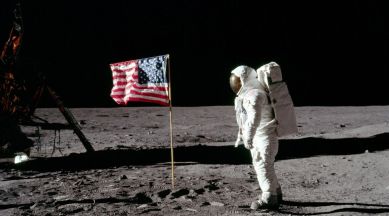Each year, July 20 is celebrated as the International Moon Day to mark the anniversary of the Apollo 11 mission’s landing on Luna.

The United Nations General Assembly declared July 20 every year to be celebrated as International Moon Day. Here is everything you need to know about the day and why it is observed.
What does the date of International Moon Day signify?
International Moon Day is celebrated on July 20 every year to mark the anniversary of the day when humans first landed on the Moon as part of NASA’s Apollo 11 mission. Astronauts Neil Armstrong and Buzz Aldrin landed on the Moon in a location that they then named Tranquility Base, on July 20, 1969.
UN’s General Assembly declared it as an international day to be observed in its resolution 76/76 on “International cooperation in the peaceful uses of outer space” in 2021.
You have exhausted your
monthly limit of free stories.
To continue reading,
simply register or sign in
Continue reading with an Indian Express Premium membership starting Rs 91 per month.
This premium article is free for now.
Register to read more free stories and access offers from partners.
Continue reading with an Indian Express Premium membership starting Rs 91 per month.
This content is exclusive for our subscribers.
Subscribe now to get unlimited access to The Indian Express exclusive and premium stories.
“As Moon exploration efforts continue taking shape with ambitious plans, this global celebration will serve not only as a reminder of success in the past, but as an annual testimony to future endeavours,” says a statement from the UN.
What happened during the Apollo 11
Apollo 11’s primary objective was fairly simple but nearly impossible—to complete the goal set by US President John F Kennedy in 1961 by landing humans on the Moon and bringing them back to Earth.
https://twitter.com/TheRealBuzz/status/1680708340329099264 https://platform.twitter.com/widgets.js
Impressively, NASA was able to reach Kennedy’s target little more than eight years after he set it. The Apollo 11 mission launched from Cape Canaveral (Cape Kennedy at the time) on July 16, 1969, carrying Neil Armstrong, Michael Collins and Buzz Aldrin. Two days later came the famous sentence uttered by Armstrong on the Moon, “one small step for a man, one giant leap for mankind.”
After landing using the mission’s Eagle module, Armstrong and Aldrin spent about 21 hours on the lunar surface, collecting around 21.5 kilograms of lunar material to bring back to Earth. While that was happening, pilot Michael Collins was flying the Columbia Command Module in the lunar orbit. Armstrong and Aldrin lifted off to rejoin Columbia at the end of their time on the Moon.
© IE Online Media Services Pvt Ltd
First published on: 19-07-2023 at 19:28 IST














































